Celeste Jordan
As this year’s excavation in Quinhagak, Alaska, draws to a close, it could not be at a better time. In Area B, permafrost soil appeared midway through the third week and has not melted. In Area A, it was uncovered on the second last day of excavating in the remaining open squares. Although permafrost is extremely inconvenient for excavating, it does help to preserve artefacts. Also, in the case of this coastal site, the frozen soil has helped to keep the site somewhat intact from seasonal storms eroding the coast and invariably destroying it.
Certainly for me, the more interesting artefacts that have been recovered over the season are those relating to Yup’ik maritime and seafaring traditions. They might not be the most spectacular but they reveal fascinating information about how Yup’ik regarded the sea, taught children about seafaring lifeways and the development and use of seafaring technologies. With three miniature kayaks, one miniature kayak paddle, sea animal and water fowl effigies (pendants, toggles for harpoon lines, mask attachments and dance sticks), three fishing net gauges, two gut skin scrapers for waterproof overwear for kayak hunters and broken gunwale sections, my directed study has been most fruitful.
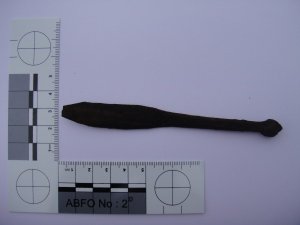
Miniature kayak paddle. Photo: Celeste Jordan 2013
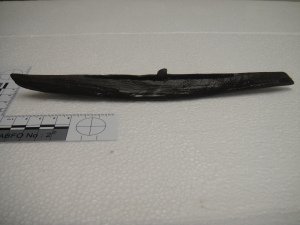
Miniature kayak made of wood. Photo: Celeste Jordan 2013
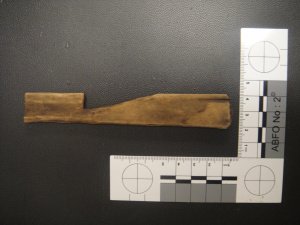
Net Gauge. Photo: Andrius Kuro 2013
This site is wonderfully diverse in terms of the archaeological sub-disciplines it falls under as well.
- Indigenous archaeology – it is a Yup’ik Eskimo site
- Pre-historic archaeology – it is pre-contact
- Rescue archaeology – coastal erosion is threatening the site
- Maritime archaeology – Yup’ik were/are a coastal community
- Palaeoecology – including faunal, insect and plant analyses
- Palaeoclimatology – Sediment and microfossil analyses
There is also a strong community archaeology focus -
- High school students worked on site as part of a summer employment program
- Teachers brought students to the site for their Earth Sciences class
- The project holds a Show and Tell of all the artefacts, in the village
- It will generate a handbook to assist the community to identify and recover data and material from other threatened archaeological sites
- Community workshops have been planned that will ensure Yup’ik voices are heard in the project
- Development of programs and resources will raise public awareness and education, and in particular will be used to develop a curriculum package for young people in schools.
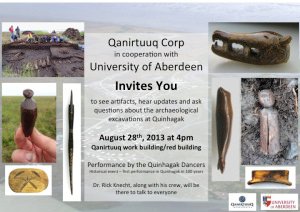
Community invitation to the Show and Tell. Developed by Celeste Jordan 2013, reproduced with the kind permission of Qanirtuuq Corp and The Nunalleq Project
It has been an excellent experience working on a terrestrial site with such varied sub-disciplines and it has given me a greater appreciation for my dirt digging cousins. I cannot imagine how challenging it would be to draw context profiles underwater – it is hard enough if your wall is not straight!
I have also gained valuable insights into the importance and gravity of community archaeology. Not only are children excited by the finds but community members often drop past just to see what we uncovered during the day. There have been a few instances where Elders have been able to shed light on artefacts and their context. However, with some artefacts, like grass matting and cordage, community members are re-learning lost traditions. The Show and Tell is an integral avenue for the greater community to learn and associate with their heritage. It is marvellous that this project is able to enrich community traditions and aid in greater understanding of why things are done the way they are.
So from Quinhagak, Alaska, I shall see most of you very soon.
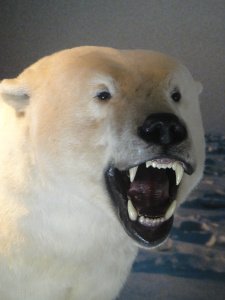
Polar bear at Anchorage airport. Photo: Celeste Jordan 2013


I really love that your work also had a community engagement part to it, a most overlooked but important part of any research : )